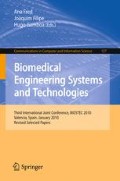Abstract
We describe a novel algorithm for texture discrimination which we tested on a robot using an artificial whisker system. Experiments on both fixed head and mobile platform have shown that this system is efficient and robust, with greater behavioral capacities than previous similar approaches, thus, demonstrating capabilities to complement or supply vision. Moreover, results tends to show that the length and number of whiskers may be an important parameter for texture discrimination. From a more fundamental point of view these results suggest that two currently opposing hypotheses to explain texture recognition in rats, namely the “kinetic signature hypothesis” and the “resonance hypothesis”, may be, in fact, complementary.
Access this chapter
Tax calculation will be finalised at checkout
Purchases are for personal use only
Preview
Unable to display preview. Download preview PDF.
References
Carvell, G., Simons, D.: Biometric analyses of vibrissal tactile discimination in the rat. Journal of Neuroscience 10, 2638–2648 (1990)
Guic-Robles, E., Valdivieso, C., Guarjardo, G.: Rats can learn a roughness discrimination using only their vibrissal system. Behavioural Brain Research 31, 285–289 (1989)
Brecht, M., Preilowski, B., Merzenich, M.: Functional architecture of the mystacial vibrissae. Behavioural Brain Research 84, 81–97 (1997)
Krupa, D.J., Matell, M.S., Brisben, A.J., Oliviera, L.M., Nicolelis, M.A.L.: Behavioural properties of the trigeminal somatosensory system in rats performing whisker-dependent tactile discrimination. J. Neurosci., 5752–5763 (2001)
Petersen, R.S., Diamond, M.E.: Spatial-Temporal Distribution of Whisker-Evoked Activity in Rat Somatosensory Cortex and the Coding of Stimulus Location. J. Neurosci. 20, 6135–6143 (2000)
Hartmann, M.J.: Active sensing capabilities of the rat whisker system. Autonomous Robots 11, 249–254 (2001)
Brooks, R.A.: A robot that walks: Emergent behaviors from a carefully evolved network. Technical Report AI MEMO 1091, MIT (1989)
Russell, R.A.: Object recognition using articulated whisker probes. In: Proc. 15th Int. Symp. Industr. Robots, pp. 605–612 (1985)
Chapman, T., Hayes, A., Tilden, T.: Reactive maze solving with a biologically-inspired wind sensor. In: Meyer, J., Berthoz, A., Floreano, D., Roitblat, H., Wilson, S. (eds.) From Animals to Animats 6. Proc. of the 6th Int. Conf. on Simulation of Adaptive Behavior, pp. 81–87. MIT PRESS, A Bradford Book (2000)
Fend, M., Bovet, S., Yokoi, H., Pfeifer, R.: An active artificial whisker array for texture discrimination. In: Proceedings of the IEEE/RSJ International Conference on Intelligent Robots and Systems (IROS), vol. II, pp. 1044–1049 (2003)
Lungarella, M., Hafner, V., Pfeifer, R., Yokoi, H.: Artificial whisker sensors in robotics. In: IEEE/RSJ International Conference on Intelligent Robots and System, vol. 3, pp. 2931–2936 (2002)
Kim, D., Moller, R.: A biomimetic whisker for texture discrimination and distance estimation. From Animals to Animats 8, 140–149 (2004)
Seth, A.K., McKinstry, J.L., Edelman, G.M., Krichmar, J.L.: Spatiotemporal processing of whisker input supports texture discrimination by a brain-based device. In: Schall, S., Ijspeert, A., Billard, A., Vijayakumar, S., Hallam, J., Meyer, J. (eds.) From Animals to Animats 8. Proc. of the 8th Int. Conf. on Simulation of Adaptive Behavior. MIT Press, MA (2004)
Fox, C.W., Mitchinson, B., Pearson, M.J., Pipe, A.G., Prescott, T.J.: Contact type dependency of texture classification in a whiskered mobile robot. Autonomous Robots (2009) (in press)
Meyer, J.A., Guillot, A., Girard, B., Khamassi, M., Pirim, P., Berthoz, A.: The psikharpax project: Towards building an artificial rat. Robotics and Autonomous Systems 50, 211–223 (2005)
N’Guyen, S., Pirim, P., Meyer, J.A.: Elastomer-based tactile sensor array for the artificial rat psikharpax. In: ISEF 2009 - XIV International Symposium on Electromagnetic Fields in Mechatronics, Electrical and Electronic Engineering (2009) (in press)
Arabzadeh, E., Panzeri, S., Diamond, M.E.: Whisker Vibration Information Carried by Rat Barrel Cortex Neurons. J. Neurosci. 24, 6011–6020 (2004)
Arabzadeh, E., Zorzin, E., Diamond, M.E.: Neuronal encoding of texture in the whisker sensory pathway. PLoS Biol. 3, e17 (2005)
Ghitza, O.: Auditory models and human performance in tasks related to speech coding and speech recognition. IEEE Transactions on Speech and Audio Processing 2, 115–132 (1994)
Kim, D.S., Lee, S.Y., Kil, R.M.: Auditory processing of speech signals for robust speech recognition in real-world noisy environments. IEEE Transactions on Speech and Audio Processing 7, 55–69 (1999)
Sreenivas, T.V., Niederjohn, R.J.: Spectral analysis for formant frequency estimation in noise. IEEE Transactions on Signal Processing 40, 282–293 (1992)
Licklider, J.C.R., Pollack, I.: Effect of differentiation, integration, and infinite peak clipping upon the intelligibility of speech. Journal of the Acoustical Society of America 20, 42–52 (1948)
Hipp, J., Arabzadeh, E., Zorzin, E., Conradt, J., Kayser, C., Diamond, M.E., Konig, P.: Texture Signals in Whisker Vibrations. J. Neurophysiol. 95, 1792–1799 (2006)
Nissen, S.: Implementation of a Fast Artificial Neural Network Library (fann). Report, Department of Computer Science University of Copenhagen (DIKU) 31 (2003)
Igel, C., Hüskel, M.: Improving the rprop learning algorithm. In: Proceedings of the Second International Symposium on Neural Computation, NC 2000, pp. 115–121 (2000)
Fend, M.: Whisker-based texture discrimination on a mobile robot. In: Capcarrère, M.S., Freitas, A.A., Bentley, P.J., Johnson, C.G., Timmis, J. (eds.) ECAL 2005. LNCS (LNAI), vol. 3630, pp. 302–311. Springer, Heidelberg (2005)
Moore, C.I., Andermann, M.L.: 2. In: The Vibrissa Resonance Hypothesis, pp. 21–60. CRC Press, Boca Raton (2005)
Neimark, M.A., Andermann, M.L., Hopfield, J.J., Moore, C.I.: Vibrissa resonance as a transduction mechanism for tactile encoding. The Journal of Neuroscience (2003)
Author information
Authors and Affiliations
Editor information
Editors and Affiliations
Rights and permissions
Copyright information
© 2011 Springer-Verlag Berlin Heidelberg
About this paper
Cite this paper
N’Guyen, S., Pirim, P., Meyer, JA. (2011). Texture Discrimination with Artificial Whiskers in the Robot-Rat Psikharpax. In: Fred, A., Filipe, J., Gamboa, H. (eds) Biomedical Engineering Systems and Technologies. BIOSTEC 2010. Communications in Computer and Information Science, vol 127. Springer, Berlin, Heidelberg. https://doi.org/10.1007/978-3-642-18472-7_20
Download citation
DOI: https://doi.org/10.1007/978-3-642-18472-7_20
Publisher Name: Springer, Berlin, Heidelberg
Print ISBN: 978-3-642-18471-0
Online ISBN: 978-3-642-18472-7
eBook Packages: Computer ScienceComputer Science (R0)

